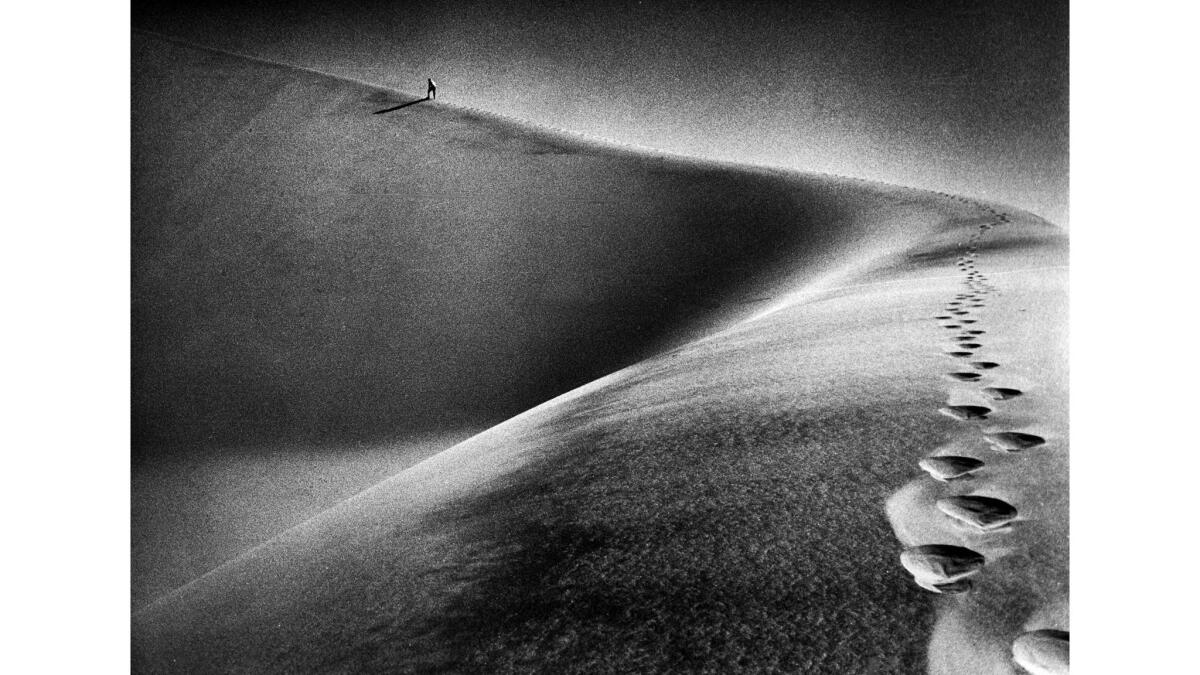From the Archives: The mysterious sounds of the Kelso Dunes

Staff writer Charles Hillinger reported in the Oct. 20, 1976, edition of the Los Angeles Times:
DEVILS PLAYGROUND, Calif. — Jack Hereford slowly made his way up the steep, seemingly razor-sharp ridge of the giant sand dune.
Each step of the way, he sank deep into the sand.
He was climbing to the summit of one of the highest sand piles in America to hear it “boom” and “sing.”
Such eerie sounds are emitted by only a few high dunes in the deserts of the world, and Hereford has been tracking them for the last 12 years.
Why some dunes boom and sing remains a mystery.
Their shape is clearly a factor. The dunes that have been found to produce the phenomenon are constantly blown on one side by winds that pile the sand higher and higher, causing the slope on the opposite, or protected, side to become quite steep and creating what is called a “slip face.”
The higher the dune, the louder the booms and other strange sounds.
But, as British physicist Ralph A. Bagnold, an authority on dunes, has written: “There is yet no real explanation of the mechanism by which the sounds are produced.”
Here in the vast, uninhabited Mohave Desert southeast of Baker, the 70-year-old Hereford was a lonely, ant-like figure as he made his way up 700-foot-high Kelso Dune.
It took the prospector-mining engineer two hours to reach the summit at the southeast end of a 25-mile sweep of sand piles called Devils Playground.
Reaching a 32-degree slip face on the lee side of the dune just beneath its peak, Hereford fell to his hands and knees and began triggering slides.
“The steepness of the slip face must be 32 degrees or awfully close to it for the phenomenon to work,” he noted.
The desert stillness was shattered by strange sounds.
Low-throated booms echoed repeatedly as a wide section of sand slid down the slope. Loud, tuba-like “umpahs” filled the air. Vibrations from the shock waves shook the peak. Other sounds rising from beneath the surface of the dune were vaguely similar to barking seals. ...
Hereford heard the booming for the first time when he climbed Kelso Dune, prospecting for magnetite, 12 years ago.
“Union Pacific Railroad tracks lie to the north of the dune. I thought it was a train going by. But there was no train,” he said. …
::
The Kelso Dunes are now part of the Mojave National Preserve. The area is closed to vehicles, but hiking is allowed.
The photo above by staff photographer Fitzgerald Whitney accompanied Hillinger’s article in the Oct. 20, 1976, edition of the Los Angeles Times. Below, I’ve added a second Whitney photo from the same shoot.
This post was originally published on Aug. 20, 2014.

See more from the Los Angeles Times archives here
More to Read
Sign up for Essential California
The most important California stories and recommendations in your inbox every morning.
You may occasionally receive promotional content from the Los Angeles Times.










